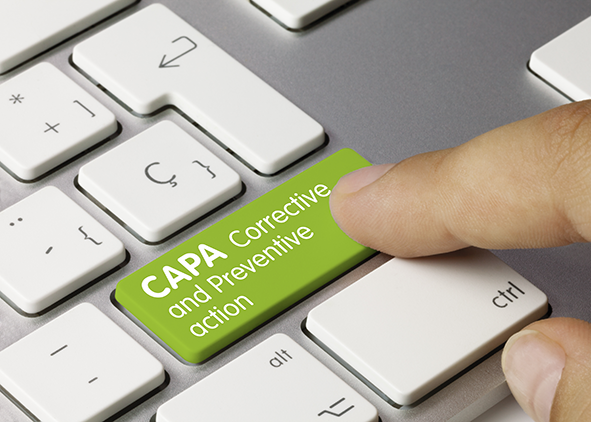The Seven Stages of CAPA
In the course of my consultations with many pharmaceutical and medical device companies, I have often seen cases in which the CAPA procedure has been developed in a self-styled (in-house) way.
An effective, fully compliant corrective and preventive action program should be systematic and can be divided into the following seven-step process
- Identification
- Evaluation Estimation of Significance and Impact
- Investigation (investigation of the cause of the problem) Planning the investigation of the problem
- Analysis Perform in-depth evaluation
- Action Plan Create a list of necessary tasks
- Implementation (implementation of actions) Action Plan
- Follow Up Verification and evaluation of effectiveness
Each step must be fully documented.
Identification
The first step in the CAPA process is to clearly define the problem or potential problem (i.e., risk). A detailed description of the problem and documentation of compelling evidence that the problem exists is necessary.
It is desirable for anyone to be able to file a CAPA. If the person who discovers a nonconformity (or the person who receives a report of a nonconformity) cannot easily file a form, quality improvement will be slow in coming.
Spontaneous CAPA (e.g., in-process non-conformances, rework, special hiring, trending (statistical methods), etc.) is desirable.
CAPAs (e.g., complaints, audit findings (internal, external, supplier, third-party audits), FDA findings, etc.) are necessary and important, but they are being handled in a backward manner, so to speak.
If CAPAs cannot be voluntarily drafted, they will not be able to cleanse themselves and the noncompliance rate will not decrease.
Each procedure should clearly state the criteria (conditions) under which the CAPA is to be drafted.
Evaluation
Estimate the severity and impact. Evaluate the potential impact of the issue and the risk to the company and its customers.
Also determine the first aid and corrective actions that will be required before a CAPA can be performed.
Evaluate the severity of the problem based on the results of the impact assessment.
Priorities for response actions will be determined according to severity.
Investigation
Develop a plan of investigation to conduct a survey of the problem and ensure that the survey is complete and that nothing has been overlooked.
The “Study Plan” shall include
・Purpose of the Survey
-The objective is a statement of the results required for corrective or preventive action.
-An investigation is complete when all aspects of its objectives have been met and verified.
・Survey Strategy
・Assign responsibilities and required resources (e.g., responsible person, person in charge)
Analysis
Perform an in-depth evaluation according to the “Research Plan.”
In the analysis, all possible causes are presumed (i.e., hypothesized) and determined to be the cause or not by collecting appropriate data.
Data collected should be organized and documented. In some cases, replicated experiments may be required.
The goal of a root cause investigation is to identify the root cause. If the root cause is not identified, corrective action cannot be taken. In other words, recurrence cannot be prevented.
It is necessary to determine the “why” that led to this situation.
Corrective actions always include the elimination of the Root Cause.
All causes must be determined in order to eliminate the root cause. This means that determining and identifying causes is an essential action for corrective action.
There can be no corrective action without an investigation of the cause.
The elimination of the identified cause is then to ensure that the same nonconformity or other undesirable situation does not occur again.
In other words, to prevent recurrence.
Pursue deficiencies, weaknesses, inadequacies, inconsistencies, and ambiguities in the system (mechanism = QMS) as the root cause.
In other words, the core of corrective action (prevention of recurrence) is to address deficiencies, weaknesses, inadequacies, inconsistencies, and ambiguities in the QMS.
However, it is not so easy to suddenly identify the root cause (true cause).
Action Plan
Based on the analysis, develop the best action plan to correct and prevent problems.
This action plan should include the changes to be implemented and the assignment of responsibilities for the tasks.
Also, as appropriate, list actions to be completed; changes in documents or specifications; changes in processes, procedures, or systems; employee training; monitoring or control to prevent recurrence of problems; and the person/persons responsible for completing each task.
If human error or human factors such as human discipline, attention, and awareness are used as corrective measures, they will eventually recur.
There is no such thing as a corrective action plan that says, “We have thoroughly conducted education and training. It is a plan to address the deficiencies of the QMS.
Implementation
Perform the tasks planned in the Action Plan.
Fully document all necessary work described in the Action Plan.
Be sure to keep a record of all procedures, documents, specifications, etc. that have been changed.
In addition, employee training should be a mandatory part of any change implementation and should be part of the action plan.
To be effective, all modifications and changes must be communicated to all personnel, departments, suppliers, etc. affected or to be affected in the future.
Follow Up
One of the most fundamental steps in the CAPA process is the validation of effectiveness (completion of the evaluation of response actions).
Effectiveness checks should evaluate the appropriateness and effectiveness of response actions, as well as verification of completion of identified tasks.
CAPA is completed when the validation of efficacy (follow-up) is completed.
dated and signed by appropriately authorized personnel.
The implemented CAPA will be reported to the management review after statistical analysis and data analysis.
It is strongly recommended that the above seven steps be prepared as a written procedure.
related product
[blogcard url=https://xn--2lwu4a.jp/qms-alex/ title=”QMS(手順書)ひな形 医薬品関連” ]]]>


Comment